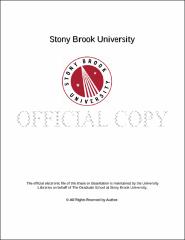| dc.identifier.uri | http://hdl.handle.net/11401/76536 | |
| dc.description.sponsorship | This work is sponsored by the Stony Brook University Graduate School in compliance with the requirements for completion of degree. | en_US |
| dc.format | Monograph | |
| dc.format.medium | Electronic Resource | en_US |
| dc.language.iso | en_US | |
| dc.publisher | The Graduate School, Stony Brook University: Stony Brook, NY. | |
| dc.type | Dissertation | |
| dcterms.abstract | Herpesviruses establish a chronic infection in the host that is characterized by intervals of lytic replication, quiescent latency, and reactivation from latency. Understanding the viral determinants of productive replication is critical for the development of novel therapeutic interventions against chronic infection with oncogenic gammaherpesviruses. Herpesviruses package proteins and RNA of host and virus origin into the viral tegument, a proteinaceous layer located between the nucleocapsid and envelope. Tegument proteins may function immediately upon deposition with the virion and throughout virus replication. Each gammaherpesvirus encodes one or more tegument proteins with homology to the cellular purine metabolism enzyme, formyl-glycineamide-phosphoribosyl-amidotransferases (FGARAT). These viral FGARATs (vFGARATs) do not retain enzymatic activity, but share a common strategy of inactivating components of ND10-nuclear bodies to counteract host intrinsic defenses. Murine gammaherpesvirus 68 (MHV68) encodes three vFGARATs: ORF75A, ORF75B, and ORF75C. ORF75C is essential for replication, but functions for ORF75A and ORF75B have not been identified. To investigate the functions of ORF75A and ORF75B, we generated a series of mutant viruses lacking ORF75A or ORF75B. MHV68∆75B had no phenotype in culture or in mice, and was not pursued further. In contrast, MHV68∆75A exhibited replication defects in fibroblasts and, to a greater extent, in primary macrophages. The replication defect in macrophages was accompanied by an increase in viral gene expression across all kinetic classes and a decrease in cell viability. Furthermore, the levels of newly delivered ORF75C tegument protein were increased in the absence of ORF75A. We next examined the contribution of ORF75A to MHV68 pathogenesis in mice. After intranasal infection, MHV68∆75A exhibited a transient one-log reduction in acute replication in the lungs that preceded a severe defect in the establishment of latency in the spleen. Intraperitoneal inoculation partially rescued the ORF75A latency defect with no added impact on reactivation from latency. These studies identify a novel role for a gammaherpesvirus vFGARAT tegument protein in replication and pathogenesis in the host. We propose a model whereby ORF75A influences the levels of tegument proteins in the virion that impact early infection events, leading to a loss of pathogenesis in vivo. | |
| dcterms.abstract | Herpesviruses establish a chronic infection in the host that is characterized by intervals of lytic replication, quiescent latency, and reactivation from latency. Understanding the viral determinants of productive replication is critical for the development of novel therapeutic interventions against chronic infection with oncogenic gammaherpesviruses. Herpesviruses package proteins and RNA of host and virus origin into the viral tegument, a proteinaceous layer located between the nucleocapsid and envelope. Tegument proteins may function immediately upon deposition with the virion and throughout virus replication. Each gammaherpesvirus encodes one or more tegument proteins with homology to the cellular purine metabolism enzyme, formyl-glycineamide-phosphoribosyl-amidotransferases (FGARAT). These viral FGARATs (vFGARATs) do not retain enzymatic activity, but share a common strategy of inactivating components of ND10-nuclear bodies to counteract host intrinsic defenses. Murine gammaherpesvirus 68 (MHV68) encodes three vFGARATs: ORF75A, ORF75B, and ORF75C. ORF75C is essential for replication, but functions for ORF75A and ORF75B have not been identified. To investigate the functions of ORF75A and ORF75B, we generated a series of mutant viruses lacking ORF75A or ORF75B. MHV68∆75B had no phenotype in culture or in mice, and was not pursued further. In contrast, MHV68∆75A exhibited replication defects in fibroblasts and, to a greater extent, in primary macrophages. The replication defect in macrophages was accompanied by an increase in viral gene expression across all kinetic classes and a decrease in cell viability. Furthermore, the levels of newly delivered ORF75C tegument protein were increased in the absence of ORF75A. We next examined the contribution of ORF75A to MHV68 pathogenesis in mice. After intranasal infection, MHV68∆75A exhibited a transient one-log reduction in acute replication in the lungs that preceded a severe defect in the establishment of latency in the spleen. Intraperitoneal inoculation partially rescued the ORF75A latency defect with no added impact on reactivation from latency. These studies identify a novel role for a gammaherpesvirus vFGARAT tegument protein in replication and pathogenesis in the host. We propose a model whereby ORF75A influences the levels of tegument proteins in the virion that impact early infection events, leading to a loss of pathogenesis in vivo. | |
| dcterms.available | 2017-09-20T16:50:35Z | |
| dcterms.contributor | Carter, Carol | en_US |
| dcterms.contributor | Krug, Laurie T | en_US |
| dcterms.contributor | Hearing, Patrick | en_US |
| dcterms.contributor | Zong, Wei-Xing | en_US |
| dcterms.contributor | French, Jarrod. | en_US |
| dcterms.creator | Minkah, Nana Kwaku | |
| dcterms.dateAccepted | 2017-09-20T16:50:35Z | |
| dcterms.dateSubmitted | 2017-09-20T16:50:35Z | |
| dcterms.description | Department of Molecular Genetics and Microbiology. | en_US |
| dcterms.extent | 205 pg. | en_US |
| dcterms.format | Application/PDF | en_US |
| dcterms.format | Monograph | |
| dcterms.identifier | http://hdl.handle.net/11401/76536 | |
| dcterms.issued | 2015-05-01 | |
| dcterms.language | en_US | |
| dcterms.provenance | Made available in DSpace on 2017-09-20T16:50:35Z (GMT). No. of bitstreams: 1
Minkah_grad.sunysb_0771E_12569.pdf: 24602935 bytes, checksum: 3c099c57cf1f756055d1a9b81937a4cd (MD5)
Previous issue date: 2015 | en |
| dcterms.publisher | The Graduate School, Stony Brook University: Stony Brook, NY. | |
| dcterms.subject | Microbiology | |
| dcterms.subject | FGARAT, Gammaherpesvirus, MHV68, pathogenesis, tegument | |
| dcterms.title | Murine gammaherpesvirus ORF75A tegument protein promotes virus replication and is required for the efficient establishment of latency in vivo | |
| dcterms.type | Dissertation | |

